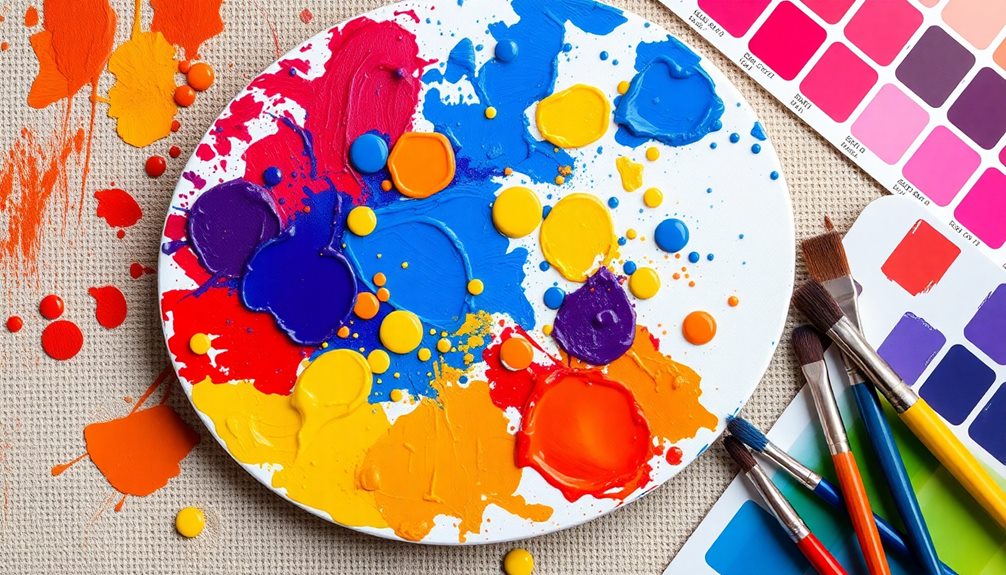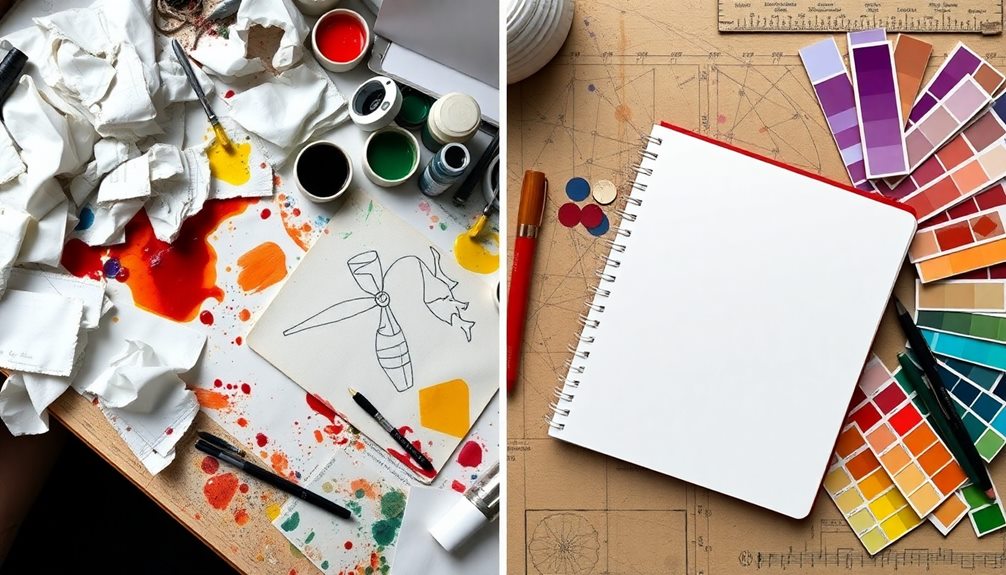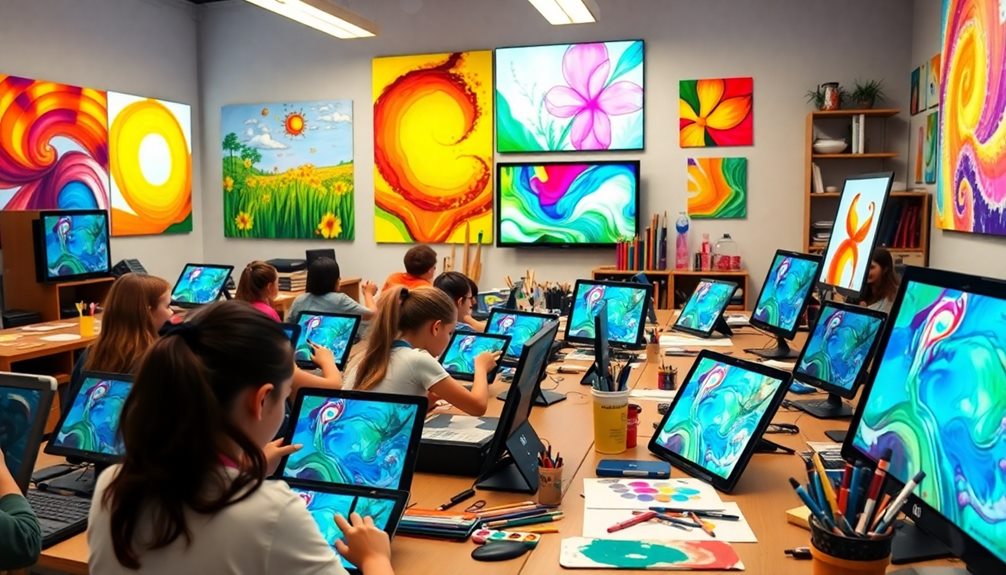To write about contemporary art, start by engaging with the work through vivid descriptions that evoke its essence and meaning. Use clear, accessible language to connect with your audience. Analyze the artwork's cultural context and significance, recognizing that your personal experiences shape your interpretation. Structure your writing clearly, focusing on your unique voice while avoiding jargon. Incorporating your thoughts on the exhibition's themes and the artist's intentions will enrich your critique. Remember, there's much more to uncover about technique and perspective that can enhance your art writing journey.
Key Takeaways
- Use vivid, descriptive language to create clarity and accessibility in your writing about contemporary art.
- Establish a clear structure with a defined introduction, body, and conclusion for your analysis.
- Engage with the artwork's historical context and cultural narratives to deepen your interpretation.
- Encourage audience feedback and participation to enhance relatability and reflect community interests.
- Regularly practice observing and writing about art to develop your unique voice and style.
Introduction

Writing about contemporary art can often feel daunting, but it's all about your unique perspective and insights. When you approach writing on this topic, you'll find that articulating your personal interpretations and analyses is key.
Start by clearly describing the artwork, using vivid, descriptive language that captures its essence. This clarity not only enhances your writing but also makes the art more accessible to your audience. As you engage with different art forms, consider how art theory informs creativity and influences your perspective.
As you delve into analysis, consider the artwork's significance within broader cultural contexts. What does it mean? Why does it matter? These questions will guide your exploration and deepen your understanding.
Avoid jargon; instead, aim for language that resonates with a general audience, fostering engagement and connection. Regular practice is essential, so don't shy away from revising your work.
Through thorough research and thoughtful reflection, you'll develop a personal style that captures the nuances of contemporary art. Embrace the challenge, and remember that your insights contribute to a richer dialogue about art's relevance today.
Key Concepts and Definitions

Understanding contemporary art requires a grasp of key concepts and definitions that shape its landscape. Contemporary art refers to art produced from the late 20th century to the present, influenced by globalization and socio-political issues. Key movements like minimalism, conceptual art, and postmodernism each present distinct philosophies and aesthetics that are essential for your comprehension.
Additionally, exploring the methods of aromatherapy can enhance your understanding of how different cultural practices influence artistic expression.
To engage deeply with contemporary works, you need to consider the historical context and the cultural narratives that inform both the artists and their creations. Important terminology, such as "readymade," "installation," and "performance art," describes unique artistic practices that you might encounter. These terms help clarify the methods and intentions behind different artworks.
Moreover, viewer interpretation is crucial in contemporary art. Your individual experiences and perspectives contribute significantly to the meaning and significance of a piece.
Understanding how these key concepts and definitions interact will enhance your appreciation and analysis of contemporary art, allowing you to articulate your insights more effectively. By familiarizing yourself with these elements, you'll be better equipped to navigate the complex and dynamic world of contemporary art.
Writing Techniques and Strategies

Crafting insightful commentary on contemporary art requires effective writing techniques and strategies that enhance your expression and clarity. Start by establishing a clear structure for your pieces, ensuring each one has a defined introduction, body, and conclusion. This organization guides your reader through your arguments effectively.
Use imaginative vocabulary that captivates your audience, but steer clear of jargon or overly complex language to maintain accessibility. Additionally, consider integrating audience engagement strategies to make your writing more relatable and impactful.
Daily practice observing and writing about art can significantly improve your appreciation and understanding, leading to more insightful critiques. Embrace revision as a crucial part of your process; always edit your drafts for clarity, precision, and coherence. Reading your work aloud can help you identify awkward phrasing or flow issues.
As you write, strive to develop your unique voice. Engage with various art forms, allowing your personal style to shine through while remaining informed by the context of the art.
Exhibition Reviews and Critiques

When it comes to expressing your thoughts on contemporary art, exhibition reviews and critiques offer a unique opportunity to share your insights with a wider audience. Start by providing a clear description of the exhibition's theme, the artworks displayed, and the overall atmosphere of the venue. This context helps readers grasp the significance of what they're about to explore.
In your critique, include your personal response to the artwork, examining both the visual elements and the conceptual framework. Reference specific pieces and discuss their relevance to the overarching theme or the artist's body of work.
Highlight the strengths and weaknesses of the exhibition, considering aspects like curation and installation, as well as how effectively the exhibition engages the audience.
Don't forget to incorporate comparative analysis with previous exhibitions or similar works. This enriches your critique, allowing readers to understand the current exhibition's impact and relevance in the contemporary art landscape.
Tips and Best Practices

Writing about contemporary art can be both rewarding and challenging, so it's important to keep a few tips and best practices in mind. First, prioritize clarity and accessibility by avoiding jargon. Use relatable language to engage a wider audience. When describing artwork, focus on specific details like the title, date, and unique characteristics while crafting a concise description that resonates.
Structure your writing logically. Start with an introduction that outlines your main points, followed by a clear analysis and a strong conclusion. This organization helps readers follow your argument and appreciate your insights.
Employ vivid language to make your descriptions dynamic. Choose strong verbs and precise adjectives to breathe life into your writing.
Remember that revision is key; read your drafts aloud to ensure flow and coherence. Don't hesitate to seek feedback from others, as fresh perspectives can help refine your work.
Audience Engagement and Feedback

Engaging your audience in discussions about contemporary art requires a thoughtful approach that goes beyond mere presentation. To achieve effective audience engagement, tailor your writing style to match the background and interests of your readers. This ensures accessibility and understanding, making the art more relatable.
Encourage feedback by posing questions and inviting open discussions. This not only fosters a sense of community but also enhances the depth of engagement with the artwork.
Utilize social media platforms to share your insights and interact with your audience, broadening your reach and inviting diverse perspectives on contemporary art.
Hosting workshops or events that incorporate audience participation can deepen their appreciation for the art and create meaningful dialogues. These experiences allow participants to share their interpretations and insights, enriching the overall conversation.
Actively seeking out audience feedback and incorporating their insights into your writing can improve its relatability and reflect the community's interests. By making your writing a collaborative effort, you create a vibrant conversation around contemporary art that resonates with both you and your audience.
Subjectivity in Artistic Interpretation

Subjectivity in artistic interpretation reveals that every viewer brings unique experiences, emotions, and cultural backgrounds to their understanding of a piece. This subjectivity leads to diverse interpretations, where what resonates with one person might seem unremarkable to another.
Remember the saying, "art is in the eye of the beholder"; your insights are just as valuable as established critiques.
Historical context plays a crucial role in shaping how you interpret art. Depending on your circumstances and background, the same artwork might evoke different reactions.
Engaging with contemporary art requires you to be open to multiple interpretations, as artists often create works that challenge conventional meanings and invite dialogue.
When you explore your interpretations, it's important to support your views with factual evidence and contextual analysis. This approach not only strengthens your perspective but also enriches the conversation around the artwork.
Embrace the diversity of thought that comes from different viewers; it can deepen your understanding and appreciation of the art.
Ultimately, subjective interpretation is a key aspect of engaging meaningfully with contemporary art, allowing you to connect with it on a personal level.
Additional Resources

When diving into the world of contemporary art writing, you'll find a wealth of resources that can guide you. One standout is the book *How to Write About Contemporary Art* by Gilda Williams. It offers practical tips tailored for both beginners and seasoned writers, ensuring you develop your skills effectively.
With over 30 illustrations and numerous case studies from 64 authors, you'll see real-world examples of successful art writing techniques. The text emphasizes avoiding jargon, promoting clarity, and using strong descriptive language to engage a wider audience. These elements are crucial in making your writing accessible and compelling.
Additionally, the comprehensive bibliography at the end serves as a treasure trove of further reading materials, enhancing your understanding of art writing. If you're considering formal training, this book is an excellent resource for art writing classes, featuring detailed instructions and exercises designed to sharpen your skills across various writing venues.
Frequently Asked Questions
How to Write About Contemporary Art Review?
To write a contemporary art review, focus on the artwork's themes, techniques, and emotional impact. Use clear language, avoid jargon, and engage your audience with personal insights, ensuring your voice resonates throughout the piece.
Conclusion
In conclusion, writing about contemporary art can be both rewarding and challenging. By understanding key concepts, employing effective techniques, and engaging with your audience, you'll enhance your ability to express your thoughts. Remember, art is subjective, so embrace your unique perspective while remaining open to different interpretations. With practice and exploration, you'll develop your voice in the art community, fostering deeper connections with both the artwork and its viewers. Keep writing and stay curious!









